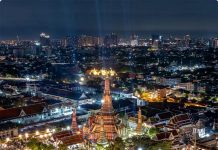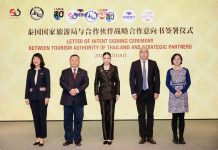Bangkok, July 21, 2011 — One of the world’s most spectacular exhibitions of candle wax sculpture is presently under way at the National Museum of Ubon Ratchathani province in Northeast Thailand, and will run until 31 July 2011.
Organised by the Tourism Authority of Thailand (TAT) and Ubon Ratchathani provincial authorities, the 6th International Wax Sculpture this year bears the theme, “Sustain Heart…Sustain World”, a reflection of the importance of both culture and nature in shaping humanity and the earth on which we live.
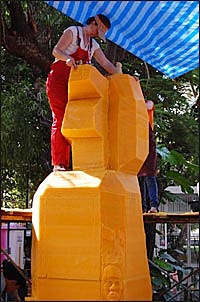
In addition to keeping ancient customs and traditions alive, this year the organizers added more contemporary elements to the traditional festival in an attempt to broaden its global appeal and attract younger visitors.
This took the form of a wax sculpture contest for artists from around the world. More than 80 candle wax sculptors expressed interest in sending their artworks but eight qualified from Japan, Nepal, Belgium, France, Ukraine, Latvia, Brazil, and Thailand.
The sculptors were invited by the TAT to join the contest with the TAT absorbing their travel and other related expenses. The sculptors also had a chance to travel in Thailand in the hope that they will narrate their experiences to their artistic colleagues, friends, families and weblog followers.
The TAT also facilitated the creation of their artwork by providing each contestant with 3 pieces of 1 square metre of wax, including the wire for framing the sculpture along with other necessary equipment.
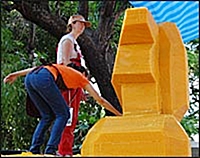
Ms Lyudmyla Mysko, from Kiev, Ukraine, who sculpted an artwork called “Song of my heart”, said she wanted her creation to reflect the beauty of the female body.
Mr Thierry Lauwers, a professional carver from Bruges, Belgium, created a sculpture in line with the contest theme, “Sustain heart…. Sustain world”. He said he wanted to reflect the creativity of the male-female relationship and emphasise the role of the family as the backbone of society.
The TAT also provided support for 10 university students from major universities ;such as, the King Mongkut Institute of Technology Ladkrabang, Silpakorn University, Maha Sarakam University and Ubon Ratchathani Vocational College to act as assistants for each artist and facilitate an exchange of ideas and experience.
Mr Borisuth Parsopsub, Assistant Director of Advertising and Public Relations, TAT said, “This festival showcases the Thai identity to the world in the same way as the Snow Sculpture Festival in Sapporo, Japan and similar events in China which receive about two million tourists a year. With sustained promotion, the International Wax Sculpture in Ubon Ratchathani can become one of the world’s top artistic events.”
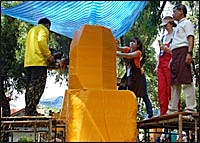
The candle wax sculpture contest is part of the annual International Candle Festival that has been organised and supported by the TAT in Ubon Ratchathani for 34 years. The Festival features a procession of ornately-carved traditional beeswax candles of various shapes and sizes.
The event attracts more than 200,000 domestic and foreign tourists, quickly filling up the downtown Ubon Ratchathani supply of 3,100 hotel rooms, as well as generating millions of Baht worth of overnight business for the neighbouring districts.
As the seasonal monsoon rains descend over the kingdom, the Festival marks the beginning of the Buddhist “rain retreat” and the Buddhist Lent, or Phansa, during which all Buddhist monks remain within the temple grounds starting from the first day of the waning moon of the eighth lunar month (in July) to the fifteenth day of the waxing moon of the eleventh lunar month (in October).
The Buddhist Lent is a time devoted to study and meditation, and an auspicious time for Buddhist ordinations as it marks a period of spiritual renewal.
In preparation for the Buddhist Lent, men with artistic skills set about moulding and sculpting Lenten candles, to be presented as Buddhist merit-making offerings. Many of these are fine examples of Buddhist art and sculpture.
The Festival has become a cultural hallmark of Ubon Ratchathani, the largest and one of the most important provinces of Northeast Thailand (known locally as I-san), located 630 kilometres from Bangkok, en route to Lao PDR.
Along with other surrounding Northeast Thai provinces; such as, Mukdahan, Sakhon Nakhon and Kalasin, it boasts some beautiful attractions including the flower fields on top of Soi Sawan Waterfall, the Dong Na Tham Forest, the Sao Chaliang Rock Pillars and the Huai Pok Waterfall.
In the years to come, the Northeast region will be an important part of the Asian Highway and the East-West and North-South Economic Corridors, a huge road network which will link the South China Sea with the Bay of Bengal, and Singapore with Kunming.
New flight connections are also being established. Thai AirAsia late last year inaugurated two new routes linking the beach resort of Phuket to both Udon Thani and Ubon Ratchathani. Domestic airline Nok Air also flies daily to both Udon and Ubon as well as the provinces of Buriram, Nakhon Phanom and Sakhon Nakhon.
Northeast Thailand has also seen the emergence of some wonderful boutique hotels that are perfect for small, exclusive groups of travellers seeking to better explore this region, while staying in comfortable surroundings.



